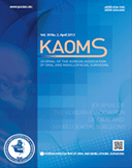Journal of the Korean Association of Oral and Maxillofacial Surgeons
- P-ISSN2234-7550
- E-ISSN2234-5930
- SCOPUS, KCI, ESCI
 ISSN : 2234-7550
ISSN : 2234-7550
한국인 치과의사의 비스포스포네이트 관련 악골괴사에 대한 인식 연구 : 예비보고
AWARENESS OF KOREAN DENTISTS ON BISPHOSPHONATE RELATED OSTEONECROSIS OF THE JAWS : PRELIMINARY REPORT
김덕윤 (경희대학교)
정윤석 (아주대학교)
이정근 (아주대학교)
김여갑 (경희대학교)
권용대 (경희대학교)
김영란 (경희대학교)
Abstract
Recently, an increasing number of bisphosphonate related osteonecrosis of the jaw(BRONJ) is being reported. A guideline has been already established in the US, but it does not seem to be fully recognized by clinicians in Korea. Therefore, a survey study was done to inform and have clinicians realize the seriousness of BRONJ. 1,341 practitioners were randomly selected out of 13,405 practitioners(by Feb of 2008, KDA) in Korea. A questionnaire was given to them between May to July in 2008. Questions were designed to investigate each respondent’s experience term years in the clinic, occupation, speciality, awareness on risk of bisphosphonate, experience on treating osteonecrosis patients, awareness about the guideline on BRONJ suggested by AAOMS and whether if they ask about bisphosphonate medication history to patients before invasive treatment. 45.1% of the clinicians have reported on experiencing delayed healing on bone exposed site after extraction both in the maxilla and the mandible. However, clinicians have asked the patients whether if they are on bisphosphonate or not in only 15.1% of these cases. 56.5% of the clinicians simply knew about BRONJ but only 28.9% of the clinicians were aware that bisphosphonate can cause osteonecrosis after invasive dental treatment. Only 19.3% knew about the contents of guideline on BRONJ and 57.2% were aware of the seriousness of BRONJ. Clinicians with shorter clinical experience term were more aware of BRONJ and the guideline on BRONJ than the experienced clinicians. But awareness of the possibility of BRONJ after invasive dental treatment were about the same regardless of their clinical experience. The results show that Korean clinicians need to be more aware about BRONJ. Data on BRONJ cases in Korea should be collected and provided with additional education to let Korean clinicians know and be more aware about BRONJ.
- keywords
- Bisphosphonate, Osteonecrosis, ONJ
- 다운로드 수
- 조회수
- 0KCI 피인용수
- 0WOS 피인용수